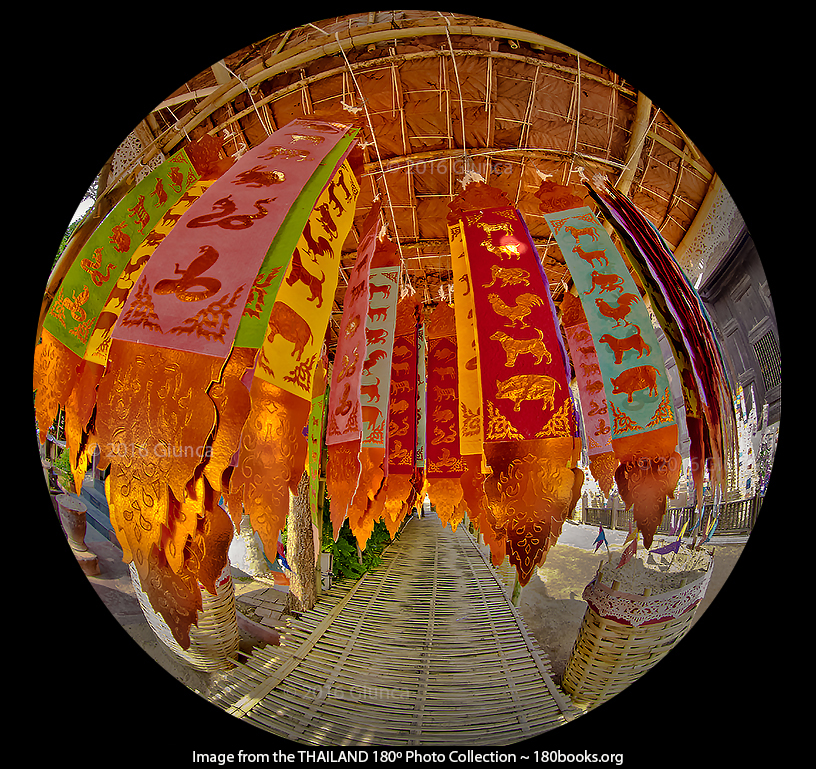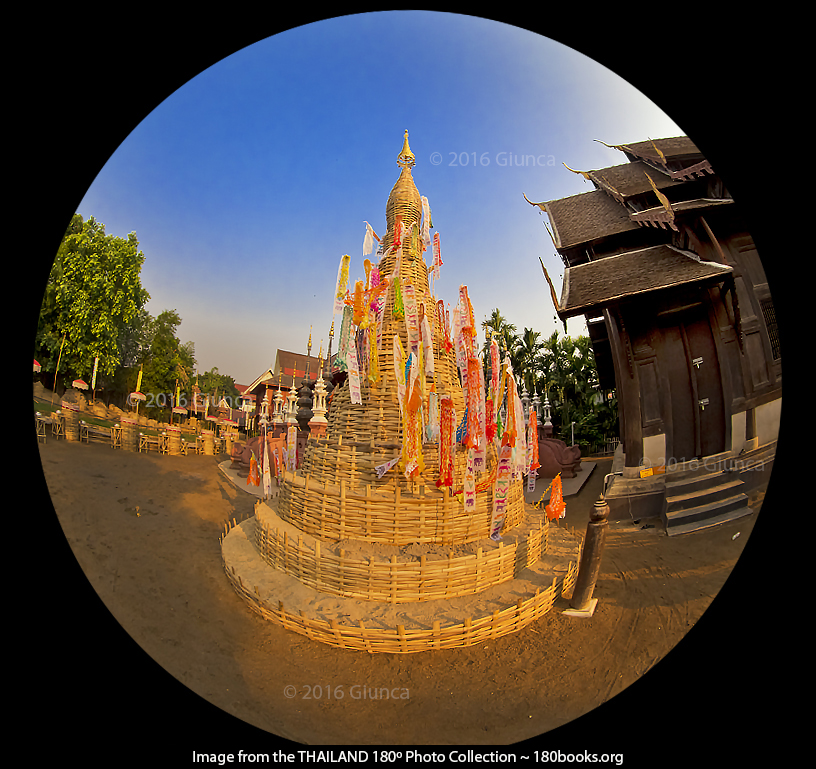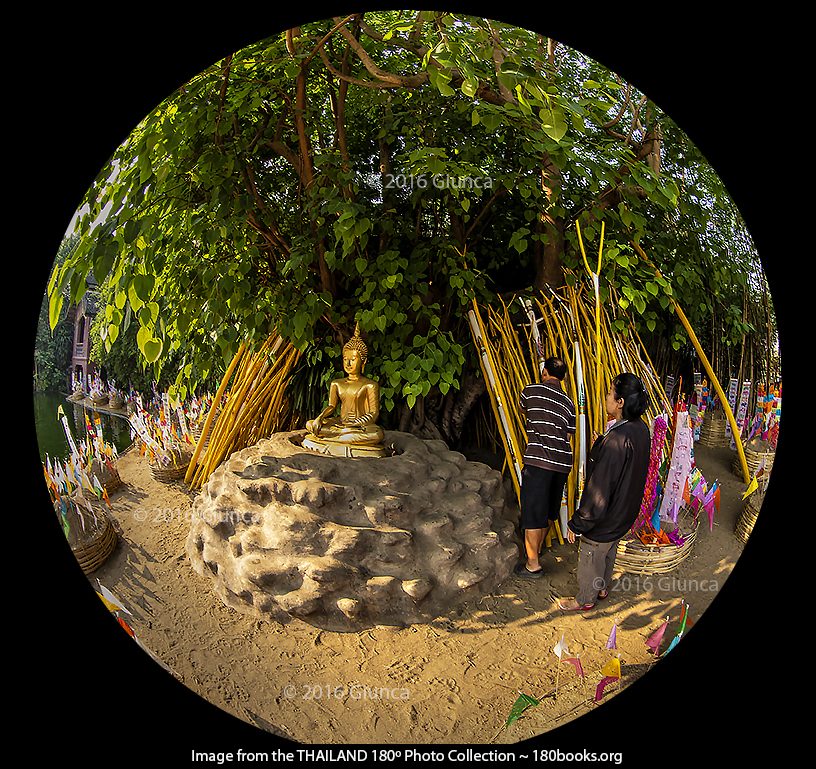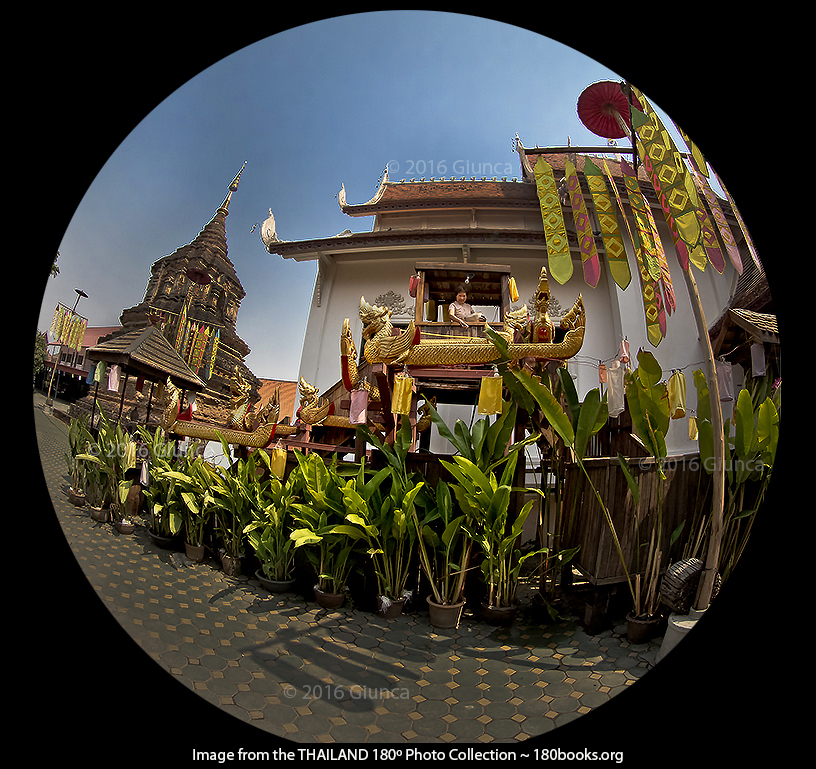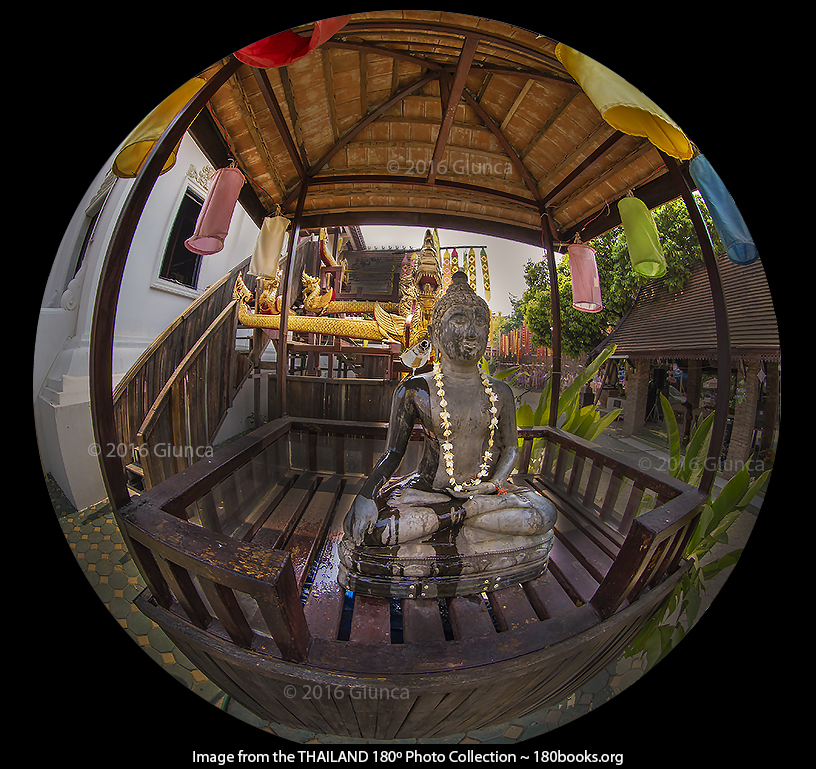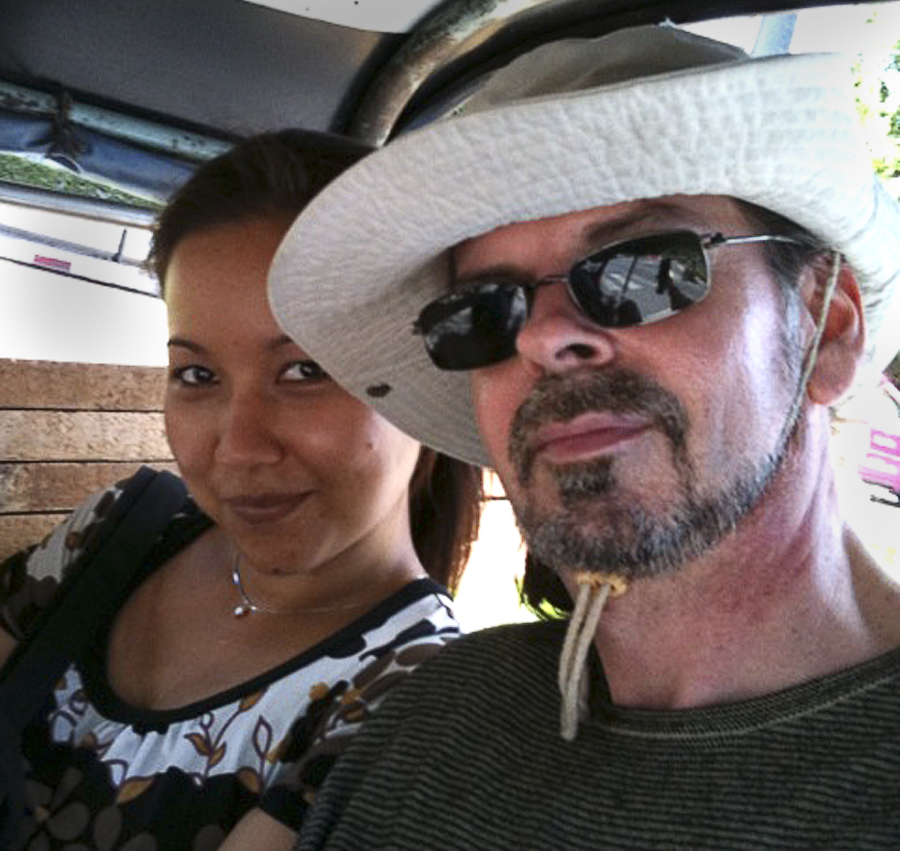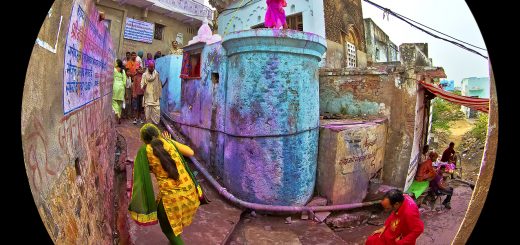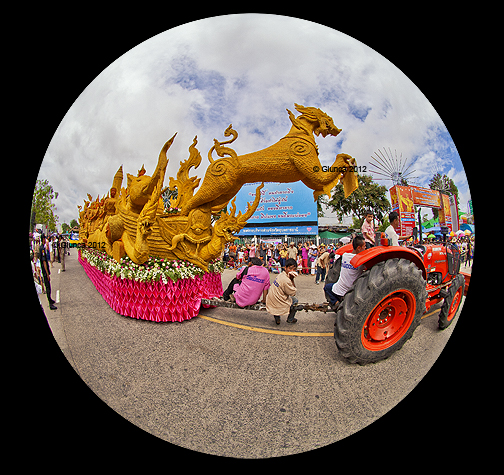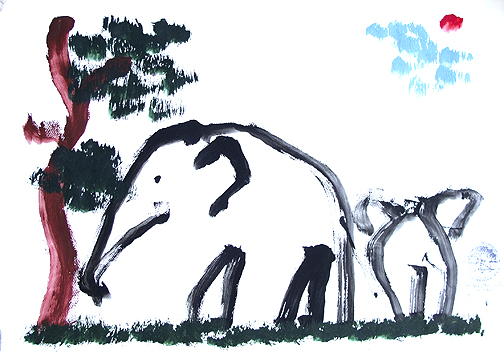The Best Songkran Ever!
สงกรานต์ (ป๋าเวณีปี๋ใหม่เมือง) ณ เชียงใหม่
Songkran, the Thai New Year was celebrated last week and things are finally getting back to normal, here in Chiang Mai, Thailand. Throwing or spraying water has become a big part of this holiday but somehow the idea of having cold water of often questionable cleanliness thrown on me is I walk around in my street clothes really annoys me, and I don’t know why the tourism people think this aspect of the holiday is a large draw for Western tourists.
Oh, did I mention that drinking alcohol or wearing swimsuits, especially bikinis is strictly prohibited?! Hey, we have fun water fights during summer holidays in our Western countries too, but we dress in appropriate clothes (beachwear), use clean water, and drink beer to take the edge off. Usually, I hide in my house in Thailand during this time, but this year we spent time researching some of the origins of Songkran and ventured out to make photos to illustrate this blog. For me, it made the holiday infinitely more meaningful!
สวัสดีปีใหม่ค่ะ .. เรานำภาพงาน “ป๋าเวณีปี๋ใหม่เมือง” มาให้ชมว่าคนเมืองเชียงใหม่เขามีประเพณีที่สืบทอดปฏิบัติกันมาช้านานและเป็นประเพณีที่มีสำคัญยิ่ง เนื่องจากเป็นการเริ่มต้นปีใหม่ มีการทำบุญทำทานให้เกิดความเป็นสิริมงคล ความงอกงาม ความสุข ความรุ่งเรือง บนพื้นฐานวัฒนธรรมประเพณีของชาวล้านนา ไม่ใช่การเสื้อซีทรู นุ่งสั้น เล่นสาดน้ำคว่ำถัง เปิดเพลงแด๊นซ์ เต้นกันเป็นไส้เดือนโดนน้ำร้อน ใครรอชมภาพพวกนี้ก็ไม่ต้องอ่านต่อนะ ปิดไปเลย เพราะอันที่จริงนักท่องเที่ยวต่างชาติเค้าก็มีสงครามสาดน้ำในกันสนุกสนานครึกครื้นกว่าบ้านเราอีก นักท่องเที่ยวจริงๆเขาอยากมาเที่ยวมาชมแบบออริจินัลมากกว่า เราเลยนำพาไปชมส่วนหนึ่งของประเพณีนี้
Songkran in the Lanna
Songkran in the Lanna culture is a blend of Yunnanese (China), Northern Vietnamese, Cambodian, Laotian, Burmese, Sri Lankan, East Bengali (India), and Tai traditions. The temple grounds are decorated in a most festive way. Colorful “Tung Tua Peung”, symbolizing the twelve birth years blow in the warm breeze.
ในทางประวัติศาสตร์ ประเทศในภูมิภาคเอเชียตะวันออกเฉียงใต้ ส่วนใหญ่ได้รับอิทธิพลทางวัฒนธรรมจากประเทศอินเดียและจีนจากการติดต่อค้าขาย ซึ่งแต่ละประเทศต่างก็รับเอาวัฒนธรรมจากทั้งสองชาตินี้เข้ามาในระดับที่แตกต่างกัน แต่ในขณะเดียวกันก็มีความคล้ายคลึงในบางส่วน ดังเช่น ประเพณีสงกรานต์ อันเป็นประเพณีปีใหม่ของประเทศไทย ลาว กัมพูชา เมียนมาร์ กลุ่มชาวไตแถบเวียดนามและมณฑลยูนนานของจีน ศรีลังกาและแถบตะวันออกของประเทศอินเดีย
Celebrating the Traditional Way
Although the celebration of this holiday has largely deteriorated into water wars and girls dressed in tacky clothes writhing to horrible music that is WAY TOO LOUD, many locals still celebrate in the traditional way.
Songkran of Lanna used to be celebrated for 7 days but nowadays it has been shortened to 4-5 days. This year it starts on April13th. Each day has its own tasks/activities following the Lanna beliefs. April 14th, called “Wan Sang Khan Long” means the day that the sun moves from zodiac sign Aries, to the Taurus sign. It’s a big cleaning day and the Lanna people clean their house and wash their hair. This is believed to get rid of the bad things from the last year.
ประเพณีปีใหม่ของชาวล้านนา ในอดีตมี ๗ วัน แต่ละวันจะมีวิถีปฏิบัติแตกต่างกันไปตามจารีตประเพณี แต่ปัจจุบันนิยมปฏิบัติกันเพียง ๔ วัน คือ วันสังขานต์ล่อง วันเน่า วันพญาวัน และวันปากปี๋ โดยตามปฏิทินล้านนาปี พ.ศ.๒๕๖๐ จะเริ่มในวันที่ ๑๔ เมษายน : วันสังขานล่อง หรือ วันมหาสงกรานต์ ถือเป็นวันลอยทุกข์ ลอยโศก ลอยความไม่เป็นมงคลต่อชีวิตออกไป ทำความสะอาดบ้านเรือนและชำระล้างกายใจให้สะอาด
April 15th called “Wan Nao”, people take sand to the temple, go shopping or prepare food and dessert for the next day. Taking sand to the temple is viewed as a charitable act and relieves the guilt of having removed sand from the temple on one’s shoes during the past year. Many years ago, this sand was cleared from the rivers to prevent flooding during the monsoon season.
วันที่ ๑๕ เมษายน : วันเนา หรือ วันเน่า ชาวล้านนาจะออกไปจ่ายตลาดเพื่อเตรียมอาหารและสิ่งของไปทำบุญที่วัดในวันต่อๆไป บางส่วนจะไปขนทรายเข้าวัดซึ่งในอดีตจะนำทรายมาจากแม่น้ำปิง แต่ปัจจุบันทางวัดจีดหามาไว้ให้ (ข้อดีทางกายภาพประการหนึ่งของการขนทรายจากน้ำปิงก็ช่วยเรื่องความตื้นเขินและน้ำล้นตลิ่งในหน้าน้ำหลาก) และนอกจากนี้ตามโบราณที่ผู้เฒ่าผู้แก่สั่งสอนลูกหลานต่อกันมาคือ วันเนา หรือ วันเน่า เป็นวันที่ต้องคิดดี ทำดี พูดดี ห้ามทำสิ่งที่ไม่เป็นมงคล ด่าทอ ทะเลาะวิวาท เพราะเชื่อว่าการทำสิ่งดีๆ ในวันนี้จะเป็นมงคลแก่ชีวิตตลอดทั้งปี
On April 16th, called “Wan Phaya Wan”, the Lanna people go to make merit at the temple; giving food to monks, dedicated to the death of family members and ancestors. Additionally, banners called tung sai moo are placed on sand chedis, Mai Kham Salees are placed under bodhi trees, and special fragrant water is poured on Buddha images. The banners placed on chedis, as in the photo above, trail downwards to the earth. Folklore has it that if one of your deceased ancestors happens to be suffering in hell, they can grab hold of the banner and pull themselves heavenward.
วันที่ ๑๖ เมษายน : วันพญาวัน หรือ วันเถลิงศก เป็นวันทำบุญใหญ่ที่ต่างพร้อมใจกันนำอาหารหวานคาวไปทำบุญที่วัด เรียกว่าทานขันข้าว เพื่ออุทิศบุญกุศลแก่ผู้ล่วงลับ จากนั้นฟังเทศน์ฟังธรรม, ทานตุงปักที่เจดีย์ทรายซึ่งก็มีทั้งตุงไส้หมู ตุงตั๋วเปิ้ง และข้าวตอกดอกไม้
Beware of Fire Ants
Tan Mai Kham Salees, shown in the image above, are long sticks with a Y-fork at the end. The act of placing a stick under a Bodhi tree tp prop up a branch affirms that you will be a Buddhist for life and support the faith. A Bodhi tree is always used, as it is the tree that Buddha sat under when he attained enlightenment. As I was taking the photo, I managed to step on a nest of fire ants. About a dozen of them started to attack my foot causing intense pain and lots of swelling later. Be sure to watch where you step as you walk on sand in tropical areas. Luckily I didn’t shout too loudly or dive into the temple pond!
ทานไม้ค้ำศรี (คำล้านนาอ่านว่าสะหลี) เป็นการถวายไม้สำหรับค้ำต้นโพธิ์ ถือคติเพื่อเป็นสัญลักษณ์ในการช่วยกันค้ำจุนพระศาสนาให้ยืนยาวต่อไป และรวมถึงดำหัวพระเจ้า หรือสรงน้ำทั้งพระพุทธรูป สถูปเจดีย์ และพระภิกษุสงฆ์ด้วยน้ำขมิ้นส้มป่อย
April 17th is called “Wan Pak Pee” and it’s the first day of the new year. This is the day you will hear the phrase Sawasdee Pee Mai which means “Happy New Year”. This is an important day to make merit at the temple pouring fragrant water on images of Buddha and the hands of elders. The elders will, in turn, bestow a short blessing upon you. After performing this ritual on the hands of our neighbor Aunty Daeng, she gave us valuable information for this blog and some special dessert wrapped in banana leaves. It is a tradition that special treats such as Gaeng Kanoon, Khanom Jok, Khao Taen, Khao Kaab, Ho Neung Gai, Larb are to be eaten on this day. As our visit ended, I saw her eyeing some young fruit on our kanoon tree. I told her to help herself to the fruit and later in the day, she returned with a tasty dish of curry which featured the fruit and pork ribs.
วันที่ ๑๗ เมษายน : วันปากปี๋ ถือเป็นวันแรกของปี บางแห่งมีการทำบุญเสาใจบ้านหรือส่งเคราะห์บ้าน บางแห่งมีพิธีสืบชาตา บางแห่งมีการดำหัวพระเถระผู้ใหญ่ แต่ที่สำคัญกับชาวล้านนาทุกคนทุกบ้านคือ การทำแกงขนุน หรือภาษาพื้นเมืองเรียกว่า “แก๋งบ่าหนุน” โดยเชื่อกันว่าเมื่อได้ทานแกงขนุนหรืออาหารที่ทำจากขนุนในวันปากปี๋จะช่วยสนับสนุนให้เกิดความเจริญรุ่งเรือง ประกอบกิจการงานใดก็สำเร็จผล มีคนมาอุดหนุนค้ำจุน อีกทั้งเกิดสิริมงคลในครอบครัวไปตลอดทั้งปี นอกจากแกงขนุนแล้วยังมีอาหารและขนมอีกหลายอย่างที่นิยมรับประทานกันในช่วงปีใหม่เมือง เช่น ขนมจ็อก หรือ ขนมนมสาว เป็นขนมที่นิยมทำ ในช่วงเทศกาลสงกรานต์มาแต่โบราณ, ข้าวต้มมัด, ข้าวแคบ ข้าวควบ, ข้าวแตน, ห่อนึ่งไก่, ลาบ เป็นต้น ป้าแดงเพื่อนบ้านที่น่ารักของเราเล่าให้ฟังเกี่ยวกับวันปีใหม่ล้านนา พร้อมหยิบขนมจ๊อกและห่อไก่นึ่งให้เรา เราบอกป้าแดงว่าขนุนน้อยที่ต้นตัดไปแกงได้เลย พอตกเย็นป้าแดงเดินกลับบ้านพร้อมแก๋งบ่าหนุนถุงใหญ่
Most of the time, pouring fragrant water on a Buddha image is accomplished using a small aluminum cup but we found this huge Rube Goldberg-like device in use at Wat Phan Tao (See images above). With this contraption known as a Rang Rin, worshippers climb up stairs and pour the water into a narrow trough designed to look like a Naga. The water travels down through seven of the Naga troughs before landing on the Buddha image. As I was marveling at this and the painfulness of the ant bites on my swollen feet, a woman who spoke excellent English asked me to photograph her pouring water. I delegated the task to my wife who is a great photographer in her own right, but after seeing how she added to the photo, I asked her if I could make the photo above for this blog. (Hello, and Thanks Once Again!)
การดำหัวพระเจ้า หรือ การสรงน้ำพระพุทธรูป แบบดั้งเดิมนั้น ใช้ “รางริน” สำหรับส่งน้ำสรงพระพุทธรูป (ภาพด้านบน) โดยวัดพันเตายังคงใช้รางรินหัวนาคแบบโบราณ มี ๗ ชั้น การสรงน้ำด้วยรางรินถือว่าเป็นการสรงน้ำที่ถูกต้องตามประเพณี น้ำที่สรงองค์พระจะไหลไปสู่ภาชนะ และถือเป็นน้ำศักดิ์สิทธิ์ที่ชาวล้านนานำมาประพรมศีรษะ ร่างกายหรือที่อยู่อาศัยเพื่อควาเป็นสิริมงคล ร่มเย็นเป็นสุขแก่ชีวิตและครอบครัวของตนสืบไป
After this year, I’ll never look at Songkran the same way again! I’ll find some local people that enjoy talking about and following their traditions and celebrate with them. After all, learning and real experiences are what make traveling so worthwhile, right?
งานประเพณีปีใหม่เมืองมีขบวนฟ้อน ขบวนสักการะบวงสรวง ตลอดจนกิจกรรมต่างๆ มากมายทุกวัน หากแต่เราควรช่วยกันรักษาประเพณีที่ถูกต้องดีงามเพื่อสืบสานป๋าเวณีปี๋ใหม่เมืองให้ยั่งยืนต่อไป … ภาพของวันสงกรานต์เชียงใหม่นี้ทำให้เรามองวันสงกรานต์แตกต่างไปจากเดิมและอยากออกไปเที่ยวงานป๋าเวณีปี๋ใหม่เมืองทุกปีเลย
เที่ยวเมืองไทย ยิ้มสุขใจ ค้นหาสิ่งแปลกใหม่ ชื่นชมความสวยงาม เปิดใจและโลกทัศน์ให้กว้าง… พบกันใหม่บล๊อกหน้าค่ะ
!!..คลิ๊กแผนที่..!! ดูภาพสวยๆ อ่านบล็อกสถานที่ท่องเที่ยวจาก THAILAND 180º ได้นะคะ อัพเดทเพิ่มเติมตลอดค่ะ
We had to eliminate the ability to comment from this wordpress site due to excessive spam. If you enjoyed this story, subscribe using the “Subscribe” button below, or visit our facebook fan page to comment Here
We’d LOVE to hear from you!
ผู้ติดตามอ่านบล็อก สามารถติดตามอัพเดทโพสต์บล็อกได้โดยสมัครสมาชิกที่บล็อกนี้ หรือ กดไลค์เฟสบุ๊คเพจของเราที่นี่ Here
Blog : Thai by Apisatha Hussadee Giunca
Blog : English by George Edward Giunca
About the Authors
Photographer George Edward Giunca, and his Thai wife, Apisatha, have traveled around Thailand armed with a circular fisheye lens to create a photo essay on the rich cultural diversity, and abundant natural beauty of the Kingdom of Thailand. Fleeing from angry water buffaloes, slapping huge mosquitoes, watching exotic festivals and religious rituals, gorging on delicious spicy food, applying aloe vera cream to sunburned skin, wading through rice paddies, getting drenched to the bone by heavy monsoon rains, and gawking at breath-taking scenery; made it a journey of epic proportions! The result is the book, THAILAND 180º. Later, they traveled extensively through Myanmar, Malaysia, and India, gathering a massive collections of 180º photos.
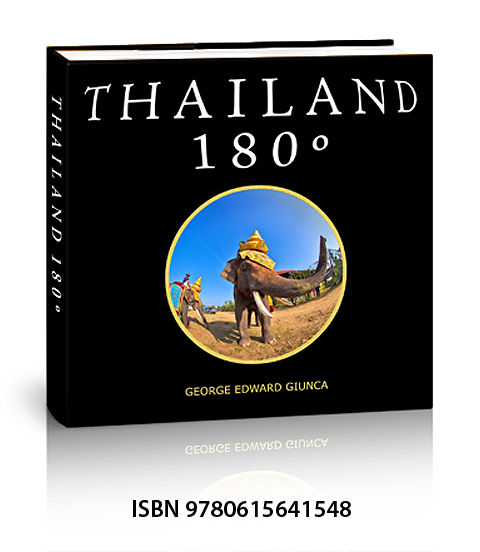 Please Note: The photos in this article do not appear in this edition of THAILAND 180º
Please Note: The photos in this article do not appear in this edition of THAILAND 180º
Here’s How to Order Your Copy of THAILAND 180º Collectors EditionToday!
In Thailand —>>>http://www.thailand180.com/thaiorder.html
The Rest of the world: We are offering our book on Amazon.com, below list price and I’ll pay for the shipping within the United States! http://amzn.to/1knDPRR
Not Familiar with Our Book???
This show details the origin of 180 Books, a series of art/travel books illustrated with a circular fisheye lens. By using infographics, pictures from our THAILAND 180º book, and never seen before images from our vault, we’ll demonstrate this unique lens and present our unique books.
Also, because there’s nothing to watch on TV, here’s a trailer about our book, “THAILAND 180”
Above is an interactive map of Thailand. If you click on a marker it reveals a photo from our THAILAND 180º book and a link to our blog article about the photo. Go Ahead~ Start Exploring ~Have Some Fun!


